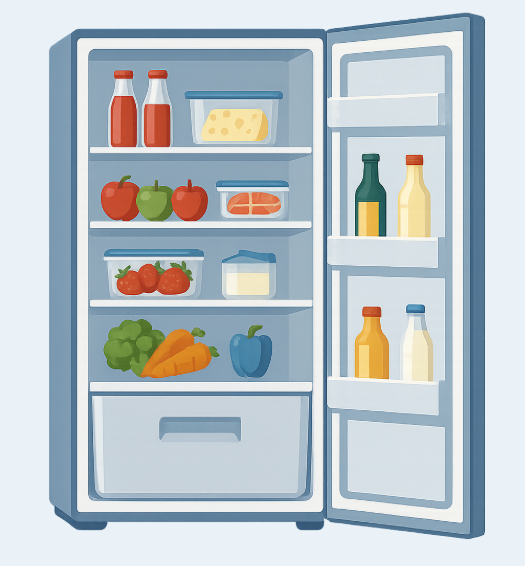Refrigerators run 24/7 and account for about 10-20% of a household’s total electricity consumption, according to the Vietnam Electricity Group (EVN). Besides choosing an energy-efficient model, how you arrange and store food inside can significantly impact the appliance’s performance.

1. Avoid Overloading or Underfilling the Fridge
A packed fridge obstructs cold air circulation, forcing the appliance to work harder and longer to cool down. Conversely, an empty fridge loses cold air more quickly when opened, wasting energy.
Experts recommend maintaining a filling level of about 70-85% of the fridge’s capacity. If your fridge is too empty, you can add bottles of water or ice packs to help stabilize the temperature.
2. Organize by Temperature Zones
The temperature inside a fridge is not uniform. The top shelf is usually cooler, ideal for eggs, milk, and dairy products. The middle shelf is for prepared meals and snacks. The bottom shelf, closest to the cooling element, is suitable for storing fresh meat and fish.
The door shelves experience the most temperature fluctuations, so only store spices, drinks, or less temperature-sensitive items there.

3. Package and Cover Food
Uncovered food loses moisture, degrades in quality, and can absorb odors, forcing the fridge to work harder to maintain its temperature. Using airtight containers, ziplock bags, or plastic wrap helps retain moisture, reduce heat loss, and prevent odors from spreading. This simple habit can reduce energy consumption by 2-5%.
4. Don’t Put Hot Food in the Fridge
Putting freshly cooked, high-temperature food in the fridge increases the internal temperature, causing the compressor to work continuously to compensate. Let food cool down to room temperature before storing it in the fridge to save energy and avoid potential damage to the appliance.
5. Maintain Space Around Foods and Fridge Walls
Spacing allows cold air to circulate evenly, preventing hot and cold spots. Avoid pressing food against the cooling element as it may cause local freezing, reducing the efficiency of the fridge.
6. Regularly Clean the Fridge
Dust and dirt on the door gasket can reduce its sealing ability, allowing cold air to escape. Cleaning the gasket once or twice a month and checking its elasticity will help the fridge maintain its temperature better. Additionally, wiping down shelves, containers, and removing spoiled food reduces odors and bacteria, preventing the fridge from working beyond its capacity.
7. Utilize Specialized Compartments and Boxes
Modern fridges often feature soft freeze compartments, humidity-controlled crispers, and 0°C zones. Using these features correctly helps keep food fresher for longer, reducing the need for frequent door openings and heat loss.
8. Minimize Door Opening and Frequency
Each time the door is opened, cold air escapes, and the fridge consumes more energy to cool down again. A well-organized and easily viewable fridge reduces search time and unnecessary door openings.
Saving energy when using a refrigerator is not just about inverter technology or brand names but also about smart food arrangement and storage habits. Maintaining optimal filling levels, zoning by temperature, covering food, and regular cleaning are simple yet effective measures.
With electricity prices on the rise, these small habits can significantly reduce monthly expenses for families while ensuring food safety and freshness.





































